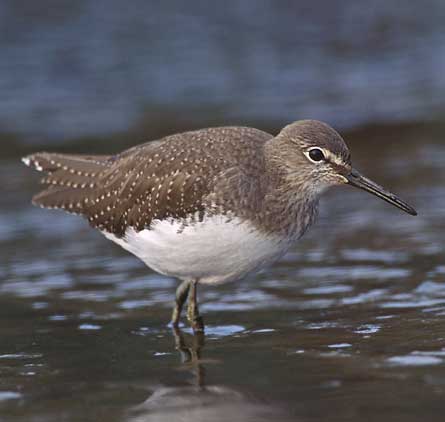
Tringa ochropus (Information about this image)
Superregnum: Eukaryota
Regnum: Animalia
Subregnum: Eumetazoa
Cladus: Bilateria
Cladus: Nephrozoa
Superphylum: Deuterostomia
Phylum: Chordata
Subphylum: Vertebrata
Infraphylum: Gnathostomata
Megaclassis: Osteichthyes
Cladus: Sarcopterygii
Cladus: Rhipidistia
Cladus: Tetrapodomorpha
Cladus: Eotetrapodiformes
Cladus: Elpistostegalia
Superclassis: Tetrapoda
Cladus: Reptiliomorpha
Cladus: Amniota
Classis: Reptilia
Cladus: Eureptilia
Cladus: Romeriida
Subclassis: Diapsida
Cladus: Sauria
Infraclassis: Archosauromorpha
Cladus: Crurotarsi
Divisio: Archosauria
Cladus: Avemetatarsalia
Cladus: Ornithodira
Subtaxon: Dinosauromorpha
Cladus: Dinosauriformes
Cladus: Dracohors
Cladus: Dinosauria
Ordo: Saurischia
Cladus: Eusaurischia
Cladus: Theropoda
Cladus: Neotheropoda
Cladus: Averostra
Cladus: Tetanurae
Cladus: Avetheropoda
Cladus: Coelurosauria
Cladus: Tyrannoraptora
Cladus: Maniraptoromorpha
Cladus: Maniraptoriformes
Cladus: Maniraptora
Cladus: Pennaraptora
Cladus: Paraves
Cladus: Eumaniraptora
Cladus: Avialae
Infraclassis: Aves
Cladus: Euavialae
Cladus: Avebrevicauda
Cladus: Pygostylia
Cladus: Ornithothoraces
Cladus: Euornithes
Cladus: Ornithuromorpha
Cladus: Ornithurae
Cladus: Carinatae
Parvclassis: Neornithes
Cohors: Neognathae
Cladus: Neoaves
Ordo: Charadriiformes
Subordo: Charadrii
Familia: Scolopacidae
Genus: Tringa
Species: Tringa ochropus
Name
Tringa ochropus Linnaeus, 1758
Synonyms
Tringa ocrophus (protonym; orth. err.)
References
Linnaeus, C. 1758. Systema Naturae per regna tria naturæ, secundum classes, ordines, genera, species, cum characteribus, differentiis, synonymis, locis, Tomus I. Editio decima, reformata. Holmiæ: impensis direct. Laurentii Salvii. i–ii, 1–824 pp DOI: 10.5962/bhl.title.542: 149. Reference page.
ICZN Opinion 411, 1953 (spelling corrected).
Vernacular names
Afrikaans: Witgatruiter
العربية: طيطوي أخضر
asturianu: Andarríu Prietu
azərbaycanca: Qara trinqa
башҡортса: Ҡара сәпсәү
беларуская: Кулік-чарняк
български: Голям горски водобегач
বাংলা: সবুজ বাটান
brezhoneg: Strelleg pastellek
català: Xivita
kaszëbsczi: Szlapnik
čeština: Vodouš kropenatý
Cymraeg: Pibydd Gwyrdd
dansk: Svaleklire
Deutsch: Waldwasserläufer
Ελληνικά: Πρασινονεραλλίδα
English: Green Sandpiper
Esperanto: Blankpuga tringo
español: Andarríos Grande
eesti: Metstilder
euskara: Kuliska ilun
suomi: Metsäviklo
føroyskt: Flykrustelkur
français: Chevalier cul-blanc
Gaeilge: Gobadán Glas
Gàidhlig: Luatharan uaine
galego: Bilurico alinegro
Gaelg: Looyran mooar
עברית: ביצנית שחורת כנף
hrvatski: Crnokrila Prutka
magyar: Erdei cankó
հայերեն: Կտցար սևուկ
Bahasa Indonesia: Burung Trinil Hijau
íslenska: Trjástelkur
italiano: Piro-piro culbianco
日本語: クサシギ
ქართული: შავულა
қазақша: Бұлыњғыр балшықшы
한국어: 삑삑도요
Lëtzebuergesch: Bëschwaasserleefer
lietuvių: Brastinis tilvikas
latviešu: Meža tilbīte
македонски: Шарена тринга
മലയാളം: കരിമ്പന് കാടക്കൊക്ക്
монгол: Сүүл цагаан хөгчүү - ᠰᠡᠭᠦᠯ ᠴᠠᠭᠠᠨ ᠬᠦᠭᠡᠴᠦ
Bahasa Melayu: Burung Kedidi Hijau
Malti: Swejda
Nederlands: Witgat
norsk nynorsk: Skogsnipe
norsk: Skogsnipe
polski: Samotnik
پنجابی: ھرا ریتپائیپر
português: Pássaro-bique-bique
rumantsch: Trintga da guaud
română: Fluierar de zăvoi
русский: Черныш
slovenčina: Kalužiak perlavý
slovenščina: Pikasti martinec
shqip: Qyrylyku këmbëpërhimë
српски / srpski: Prudnik pijukavac - Прудник пијукавац
svenska: Skogssnäppa
Kiswahili: Chamchanga Kijani
தமிழ்: Aatru Ullan
ไทย: นกชายเลนเขียว
Türkçe: Yeşil düdükçün
українська: Коловодник лісовий
Tiếng Việt: Chim Choắt bụng trắng
中文: 白腰草鹬
The green sandpiper (Tringa ochropus) is a small wader (shorebird) of the Old World.
The green sandpiper represents an ancient lineage of the genus Tringa; its only close living relative is the solitary sandpiper (T. solitaria). They both have brown wings with little light dots and a delicate but contrasting neck and chest pattern. In addition, both species nest in trees, unlike most other scolopacids.[2]
Given its basal position in Tringa, it is fairly unsurprising that suspected cases of hybridisation between this species and the common sandpiper (A. hypoleucos) of the sister genus Actitis have been reported.
Taxonomy
The green sandpiper was formally described by the Swedish naturalist Carl Linnaeus in 1758 in the tenth edition of his Systema Naturae under the current binomial name Tringa ochropus.[3] The genus name Tringa is the New Latin name given to the green sandpiper by Aldrovandus in 1599 based on Ancient Greek trungas, a thrush-sized, white-rumped, tail-bobbing wading bird mentioned by Aristotle. The specific ochropus is from Ancient Greek okhros, "ochre", and pous, "foot".[4] The species is monotypic: no subspecies are recognised.[5]
Description
This species is a somewhat plump wader with a dark greenish-brown back and wings, greyish head and breast and otherwise white underparts. The back is spotted white to varying extents, being maximal in the breeding adult, and less in winter and young birds. The legs and short bill are both dark green.
It is conspicuous and characteristically patterned in flight, with the wings dark above and below and a brilliant white rump. The latter feature reliably distinguishes it from the slightly smaller but otherwise very similar solitary sandpiper (T. solitaria) of North America.
In flight it has a characteristic three-note whistle.
Distribution and migration
Eggs, Museum Wiesbaden
The green sandpiper breeds across subarctic Europe and east across the Palearctic and is a migratory bird, wintering in southern Europe, the Indian Subcontinent, Southeast Asia, and tropical Africa. Food is small invertebrate items picked off the mud as this species works steadily around the edges of its chosen pond.
This is not a gregarious species, although sometimes small numbers congregate in suitable feeding areas. Green sandpiper is very much a bird of freshwater, and is often found in sites too restricted for other waders, which tend to like a clear all-round view.
Breeding
It lays 2–4 eggs in an old tree nest of another species, such as a fieldfare (Turdus pilaris). The clutch takes about three weeks to hatch.
Status
Widely distributed and not uncommon, the green sandpiper is not considered a threatened species by the IUCN on a global scale.[1] It is one of the species to which the Agreement on the Conservation of African-Eurasian Migratory Waterbirds (AEWA) applies.[6]
References
BirdLife International (2016). "Tringa ochropus". IUCN Red List of Threatened Species. 2016: e.T22693243A86680632. doi:10.2305/IUCN.UK.2016-3.RLTS.T22693243A86680632.en. Retrieved 12 November 2021.
Pereira, S.L.; Baker, A.J. (2005). "Multiple Gene Evidence for Parallel Evolution and Retention of Ancestral Morphological States in the Shanks (Charadriiformes: Scolopacidae)". Condor. 107 (3): 514–526. doi:10.1650/0010-5422(2005)107[0514:MGEFPE]2.0.CO;2.
Linnaeus, Carl (1758). Systema Naturae per regna tria naturae, secundum classes, ordines, genera, species, cum characteribus, differentiis, synonymis, locis (in Latin). Vol. 1 (10th ed.). Holmiae (Stockholm): Laurentii Salvii. p. 149.
Jobling, James A (2010). The Helm Dictionary of Scientific Bird Names. London: Christopher Helm. pp. 279, 390. ISBN 978-1-4081-2501-4.
Gill, Frank; Donsker, David; Rasmussen, Pamela, eds. (July 2021). "Sandpipers, snipes, coursers". IOC World Bird List Version 11.2. International Ornithologists' Union. Retrieved 22 November 2021.
"Species". Agreement on the Conservation of African-Eurasian Migratory Waterbirds (AEWA). Retrieved 14 November 2021.
Retrieved from "http://en.wikipedia.org/"
All text is available under the terms of the GNU Free Documentation License

